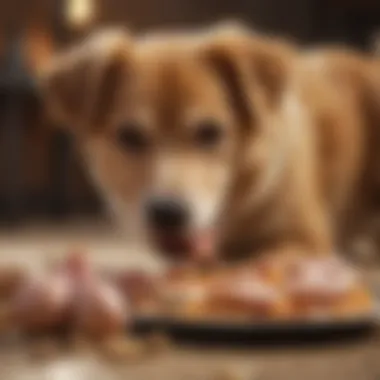Is Raw Chicken Safe for Dogs? A Detailed Guide to Feeding Practices


Animal Species Profile
When considering whether you can feed your dog raw chicken, it is essential to understand the implications of such a dietary choice. Dogs, known scientifically as Canis lupus familiaris, are domesticated mammals renowned for their close relationship with humans. These animals display a wide range of physical characteristics, exhibiting various sizes, coat colors, and shapes depending on their breed. Originally descended from wolves, dogs have adapted over centuries to become cherished companions in human households worldwide.
Is Raw Chicken Safe for Dogs?
The safety of feeding raw chicken to dogs remains a contentious topic within the veterinary and pet care communities. While some argue that raw diets can promote better health and nutrition for dogs, others express concerns regarding the potential risks of bacterial infections such as salmonella or E. coli. It is crucial for pet owners to weigh the benefits and risks carefully, considering factors such as their dog's overall health, age, and susceptibility to foodborne illnesses.
Benefits of Raw Chicken
Proponents of feeding raw chicken to dogs advocate for its potential benefits, including improved digestion, dental health, and nutrient absorption. Raw diets are believed to mimic what dogs would eat in the wild, emphasizing fresh, unprocessed foods. Advocates suggest that this diet can contribute to shinier coats, healthier skin, and increased energy levels in dogs. However, it is important to consult with a veterinarian before making any significant dietary changes for your pet.
Risks of Raw Chicken
Conversely, opponents of raw chicken diets for dogs raise concerns about the dangers of bacterial contamination and potential nutritional imbalances. Raw meat can harbor harmful pathogens that may lead to food poisoning in dogs and humans alike. Furthermore, improper handling or storage of raw chicken can heighten the risk of illness transmission. It is crucial to follow strict food safety precautions and consider alternative feeding options to minimize health risks.
Expert Insights and Recommendations
Veterinary professionals recommend a cautious approach when considering a raw chicken diet for dogs. Consulting with a veterinarian who specializes in pet nutrition can provide valuable insights tailored to your dog's specific needs. Additionally, exploring reputable sources of information on raw diets and seeking guidance from experienced pet owners can help you make informed decisions about your dog's dietary requirements. Remember that each dog is unique, and what works for one may not be suitable for another.
Introduction
In considering the debate over feeding raw chicken to dogs, it is crucial to delve into the potential risks and benefits associated with this controversial topic. This comprehensive guide aims to provide insightful information for pet owners exploring the idea of incorporating raw chicken into their dog's diet. By addressing key concerns and offering expert opinions, this article seeks to educate and guide individuals towards making informed decisions regarding their pet's nutrition.
Understanding the Debate
Historical Perspective
Exploring the historical perspective of feeding raw chicken to dogs sheds light on its origin and evolution over time. Historically, dogs have been scavengers, consuming raw meats in the wild. This practice stems from a time when dogs relied on hunting for survival, leading to a preference for raw, unprocessed food. Understanding this evolutionary aspect is crucial in comprehending the natural inclination of dogs towards raw diets. However, with the domestication of dogs and advancements in pet nutrition, the debate around the safety and efficacy of feeding raw chicken has intensified.
Current Trends
Analyzing current trends in pet nutrition reveals a growing interest in raw food diets for dogs. Pet owners are increasingly opting for natural, minimally processed diets to enhance their pet's overall health and well-being. The shift towards raw feeding reflects a desire to mimic dogs' ancestral diet and provide them with a nutrient-dense, biologically appropriate food source. Despite the popularity of raw diets, controversies surrounding bacterial contamination and nutritional imbalance persist, urging pet owners to weigh the risks and benefits carefully.
Nutritional Considerations
When considering the nutritional aspects of feeding raw chicken to dogs, it is essential to assess the bioavailability of nutrients, the presence of healthy fats and proteins, and the potential digestive benefits offered by this diet. Raw chicken provides a rich source of essential nutrients in a natural form, promoting optimal health and vitality in dogs. Additionally, the raw diet advocates argue that unprocessed foods are easier for dogs to digest, leading to improved gastrointestinal health and nutrient absorption.
Scope of the Article


Research Objectives
The primary research objective of this article is to examine the critical aspects of feeding raw chicken to dogs, including the microbiological risks, nutritional advantages, and expert recommendations. By elucidating the scientific rationale behind raw feeding and evaluating its implications on canine health, this guide aims to offer a comprehensive overview of the subject. Through a systematic analysis of existing literature and expert opinions, readers can gain valuable insights into the complexities surrounding raw diets for dogs.
Key Questions Addressed
Key questions addressed in this article encompass the safety of raw chicken consumption for dogs, the potential benefits of a raw food diet, and the practical considerations for pet owners transitioning to raw feeding. By addressing these foundational questions, pet owners can navigate the intricacies of raw feeding with confidence and make informed choices that align with their pet's dietary needs and preferences.
Benefits of Feeding Raw Chicken
Feeding raw chicken to your dog can have significant benefits worth exploring. One crucial aspect is the nutritional value it offers. Raw chicken is rich in essential nutrients that are highly bioavailable, meaning they are easily absorbed and utilized by your dog's body. This bioavailability ensures that your dog can reap the maximum nutritional benefits from the raw chicken, promoting overall health and well-being. In addition to this, raw chicken contains healthy fats and proteins necessary for optimal canine nutrition. The presence of these macronutrients supports your dog's energy levels, muscle development, and overall bodily functions. Moreover, there are potential digestive benefits associated with feeding raw chicken to dogs. The natural enzymes present in raw chicken can aid in digestion and contribute to a healthy digestive system for your furry companion.
Nutritional Value
When considering the nutritional value of raw chicken for dogs, the bioavailability of nutrients plays a pivotal role. The bioavailability of nutrients refers to how easily these essential compounds can be absorbed and utilized by the dog's body. Raw chicken offers high bioavailability, ensuring that your dog can efficiently absorb key nutrients like proteins, vitamins, and minerals. This characteristic is beneficial as it maximizes the nutritional benefits derived from feeding raw chicken, supporting your dog's overall health and vitality. Despite this advantage, it's important to note that overfeeding raw chicken can lead to nutrient imbalances, emphasizing the need for a balanced diet. Therefore, while the bioavailability of nutrients in raw chicken is advantageous, moderation and balance are key for maintaining your dog's health.
Healthy Fats and Proteins
Raw chicken is a natural source of healthy fats and proteins that are essential for your dog's well-being. The fats present in raw chicken provide a concentrated source of energy for your dog, supporting their daily activities and metabolic functions. Additionally, proteins from raw chicken are vital for muscle development, tissue repair, and immune function. By including raw chicken in your dog's diet, you can ensure they receive adequate levels of these essential macronutrients, promoting overall health and vitality.
Potential Digestive Benefits
Feeding raw chicken to your dog may have digestive benefits owing to the natural enzymes present in raw meat. These enzymes aid in the digestion process, breaking down food more efficiently and supporting a healthy gut. As a result, your dog may experience improved digestion, reduced digestive issues, and better nutrient absorption. However, it's essential to introduce raw chicken gradually into your dog's diet to allow their digestive system to adjust and monitor any adverse reactions to ensure they tolerate it well.
Dietary Variety
Incorporating dietary variety through raw chicken can bring a range of benefits for your dog. One key aspect is the rotation of protein sources, which helps prevent food sensitivities and ensures your dog receives a diverse array of nutrients. By offering different protein sources like raw chicken, you can cater to your dog's evolving nutritional needs and preferences, promoting a well-rounded diet.
Guideline for Pet Owners: The Bottom Line
Taking the leap into feeding your dog raw chicken requires careful consideration and attentive care. Ensure the raw chicken is handled safely, following proper precautions during preparation and storage to prevent bacterial contamination. Gradually transitioning your dog to a raw diet allows their digestive system to adapt, while monitoring any health changes is crucial for their well-being. Consulting a professional veterinarian or nutritionist can provide tailored advice and guidance based on your dog's individual needs and health status. By following these guidelines, pet owners can make informed decisions regarding feeding raw chicken to their furry companions, encompassing their well-being and nutritional requirements.
Risks Associated with Feeding Raw Chicken
Feeding raw chicken to dogs comes with various risks that pet owners need to consider. Understanding the potential hazards is crucial to making informed decisions about your dog's diet. This section will delve into different aspects related to the risks associated with feeding raw chicken, shedding light on the importance of this topic within the broader discussion.
Bacterial Contamination
Bacterial contamination is a significant concern when it comes to feeding raw chicken to dogs. Among the various types of bacteria that can be present in raw chicken, three main culprits stand out: Salmonella, Campylobacter, and E. coli.
Salmonella


Salmonella is a type of bacteria commonly found in raw poultry, including chicken. It can lead to food poisoning in both dogs and humans. The unique characteristic of Salmonella is its ability to survive in various environments, making it a resilient and potentially harmful choice for raw feeding. While raw food enthusiasts believe in the benefits of a natural diet, the presence of Salmonella raises serious health concerns, particularly in vulnerable individuals.
Campylobacter
Campylobacter is another bacterium often present in raw chicken, causing infections in animals and humans. Its key characteristic lies in its ability to cause gastroenteritis, leading to symptoms such as diarrhea and abdominal cramps. Despite the proponents of raw diets advocating for the simplicity and nutritional value of feeding raw, Campylobacter's risks cannot be ignored, highlighting the potential drawbacks of raw chicken consumption.
E. Coli
E. coli is a bacteria strain that can contaminate raw chicken and pose health risks to dogs. The main characteristic of E. coli is its association with foodborne illnesses, manifesting as gastrointestinal disturbances. While the appeal of a natural diet for dogs is understandable, the risks associated with E. coli emphasize the importance of safe food handling and thorough cooking. By exploring these bacterial contaminants, pet owners can grasp the significance of maintaining caution when considering raw chicken in their dog's diet.
Nutritional Imbalance
Apart from bacterial contamination, another risk linked to feeding raw chicken is nutritional imbalance. Incomplete diets, skewed calcium-phosphorus ratios, and vitamin and mineral deficiencies are aspects that pet owners should be mindful of to ensure their dog's overall well-being.
Incomplete Diets
Feeding raw chicken exclusively may result in incomplete diets for dogs, lacking essential nutrients vital for their health. The key characteristic of an incomplete diet is the deficiency in providing a balanced array of nutrients, potentially leading to health issues over time. While the appeal of raw feeding lies in its natural appeal, overlooking the necessity of a well-rounded diet could have detrimental effects on a dog's health.
Calcium-Phosphorus Ratio
Maintaining the correct calcium-phosphorus ratio is crucial for a dog's bone health and overall growth. Deviations from the optimal ratio can result in skeletal problems and metabolic imbalances. Ensuring a balanced diet with the appropriate amounts of calcium and phosphorus is essential to prevent complications associated with skeletal development. Despite the allure of raw diets for canines, improper ratios highlight the importance of understanding nutritional requirements for optimal health.
Vitamin and Mineral Deficiencies
Vitamin and mineral deficiencies can arise from an inadequately planned raw diet, affecting various bodily functions and vitality. The key characteristic of this risk is the insufficiency of essential micronutrients vital for a dog's immunity and overall health. While proponents of raw feeding advocate for its simplicity, overlooking the balance of vitamins and minerals could lead to severe health consequences. Understanding the potential deficiencies associated with raw chicken consumption is imperative for pet owners to make informed choices regarding their dog's nutrition.
Expert Opinions
In this article, the segment dedicated to Expert Opinions plays a crucial role in providing valuable insights from professionals in the field. Expert opinions offer a well-rounded perspective on the topic of feeding dogs raw chicken by shedding light on both the advantages and risks associated with this dietary choice. Veterinarians and nutritionists contribute their expertise to guide pet owners in making informed decisions regarding their dogs' nutrition. By incorporating expert opinions, this article aims to present a comprehensive view that considers various factors influencing the debate around raw chicken consumption for dogs.
Veterinarians' Views
Pros and Cons
Delving into the pros and cons related to feeding raw chicken to dogs is essential for offering a balanced viewpoint on the matter. Veterinarians highlight the benefits of raw chicken, such as its potential to provide the necessary nutrients for canine health. On the flip side, the cons focus on the risks of bacterial contamination and nutritional imbalances that may arise from this diet. By examining both aspects, pet owners are equipped with the information needed to weigh the advantages and disadvantages, enabling them to make well-informed choices regarding their dogs' diet.
Recommendations
Providing recommendations based on veterinarians' views adds a practical dimension to the discussion. These recommendations serve as actionable advice for pet owners interested in incorporating raw chicken into their dogs' diet. Veterinarians may suggest guidelines on safe handling practices, transitioning to a raw diet gradually, and monitoring their pet's health during the process. By heeding these recommendations, pet owners can navigate the challenges and potential pitfalls associated with raw chicken feeding more effectively, ensuring the well-being of their canine companions.
Nutritionists' Perspectives


Balanced Diet Principles
Nutritionists emphasize the importance of balanced diet principles when considering raw chicken as part of a dog's nutrition. Highlighting the need for a comprehensive and diverse diet, balanced diet principles underscore the significance of including various nutrients in the right proportions to promote overall health and well-being in dogs. By adhering to these principles, pet owners can ensure that their dogs receive a well-rounded diet that meets their nutritional requirements.
Individual Considerations
Taking into account individual considerations adds a personalized touch to the discussion on raw chicken feeding. Nutritionists understand that each dog is unique in terms of dietary needs, preferences, and health conditions. By considering these individual factors, such as age, breed, and any existing health issues, nutritionists can tailor recommendations to suit the specific requirements of a particular dog. Addressing individual considerations ensures that the advice provided is not only practical but also tailored to optimize the health and happiness of each furry companion.
Guidelines for Pet Owners
In this article, the section on Guidelines for Pet Owners plays a crucial role in providing pet owners with essential knowledge and insights on feeding raw chicken to dogs. Pet owners need to be well-informed about safe practices and considerations when opting for a raw diet to ensure the health and well-being of their furry companions. By following these guidelines, pet owners can mitigate potential risks and maximize the benefits of incorporating raw chicken into their dog's diet, creating a balanced and nutritious meal plan.
Safe Handling Practices
Precautions during Preparation
When it comes to discussing Precautions during Preparation of raw chicken for dogs, meticulous attention to detail is key. Pet owners must prioritize hygiene and food safety to prevent contamination and ensure the quality of the meal. Emphasizing the use of separate utensils and cutting boards for raw chicken, proper handwashing, and thorough cleaning of equipment are fundamental precautions that pet owners should adopt. By implementing these measures, the risk of bacterial contamination and foodborne illnesses can be significantly reduced.
Storage Recommendations
Effective Storage Recommendations are imperative in maintaining the freshness and quality of raw chicken for dogs. Pet owners should store raw chicken in airtight containers in the refrigerator or freezer to prevent bacterial growth and spoilage. Proper labeling with dates and rotating stock can help ensure that the chicken remains safe for consumption. By following appropriate storage practices, pet owners can prolong the shelf life of raw chicken and safeguard their pet's health.
Preventing Cross-Contamination
Preventing Cross-Contamination is essential to uphold food safety standards when handling raw chicken. Pet owners should be vigilant in cleaning surfaces, utensils, and hands after contact with raw chicken to prevent the spread of bacteria. Utilizing separate preparation areas for raw meat and other ingredients, such as fruits and vegetables, can minimize the risk of cross-contamination. By implementing strict practices to prevent cross-contamination, pet owners can maintain the integrity of the raw chicken and ensure a safe feeding experience for their dogs.
Transitioning to Raw Diet
Gradual Introduction
Gradual Introduction is a key aspect of transitioning dogs to a raw diet to avoid gastrointestinal upset and nutrient imbalances. Slowly incorporating small amounts of raw chicken into the dog's existing diet allows their digestive system to adapt to the new protein source. This gradual approach helps prevent digestive disturbances and allows for proper nutrient absorption. By introducing raw chicken gradually, pet owners can observe how their dog responds to the diet change and make adjustments accordingly for optimal health.
Monitoring Health Changes
Monitoring Health Changes is crucial during the transition to a raw diet to assess the dog's response and well-being. Pet owners should closely monitor their dog for any signs of allergies, digestive issues, or nutritional deficiencies when introducing raw chicken. Observing changes in coat quality, energy levels, stool consistency, and overall health can provide valuable insights into the dog's nutritional status. By maintaining vigilant health monitoring, pet owners can address any concerns promptly and tailor the raw diet to meet their dog's specific needs.
Seeking Professional Advice
Seeking Professional Advice from veterinarians or animal nutritionists is highly recommended when transitioning to a raw diet. Professionals can offer personalized guidance based on the dog's individual requirements and ensure a balanced and complete nutritional intake. Consulting with experts can help pet owners navigate the complexities of a raw diet, address any concerns or challenges effectively, and make informed decisions for their pet's health. By seeking professional advice, pet owners can gain confidence in providing a safe and nutritious raw diet for their beloved canine companions.
Conclusion
The Conclusion section of this comprehensive guide on feeding raw chicken to dogs serves as the pivotal endpoint, encapsulating the essence of the entire discourse. It consolidates the arguments on both the benefits and risks associated with this dietary option while offering a nuanced perspective for pet owners to consider. By delving into the intricacies of feeding raw chicken to dogs, this section brings to light the critical importance of informed decision-making in pet care.
Throughout the preceding sections, the complexities of raw chicken nutrition, the potential hazards of bacterial contamination, and the expert viewpoints have been dissected with meticulous detail. The Conclusion, therefore, acts as a synthesizing agent, drawing together these diverse strands of information into a cohesive narrative.
In essence, the Conclusion not only reiterates key findings but also emphasizes the need for responsible pet ownership. By weighing the advantages against the drawbacks, pet owners are urged to make well-informed choices regarding their canine companions' diets. This section underscores the significance of understanding the nutritional requirements of dogs and the potential implications of raw food consumption.
Furthermore, the Conclusion imparts a sense of caution and prudence, advising pet owners to approach raw chicken feeding with a discerning eye. It underscores the importance of vigilance in handling raw meat, maintaining proper hygiene, and seeking professional guidance when necessary. By highlighting the complexities and considerations surrounding raw chicken diet for dogs, this guide equips readers with the knowledge needed to navigate this contentious topic with care and awareness.







